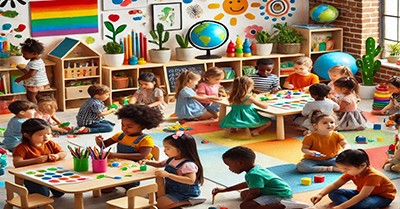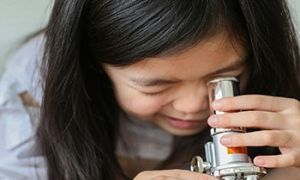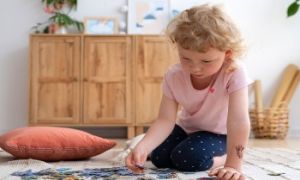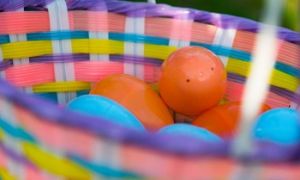Learning centers in early childhood education are dedicated areas within the learning environments where children engage in specific activities designed to develop various skills. The following article provides information on Benefits Of Using Learning Centres, Types Of Learning Centres, Outdoor Learning Centres, Advantages Of Incorporating Learning Centres Into Early Childhood Programs, How To Plan For Learning Centres, Materials Needed For Each Learning Centre and more.
Benefits Of Using Learning Centres
1. Promotes Independence
-
Self-Guided Learning: Children choose activities that interest them, promoting independence and decision-making skills.
-
Example: A child might choose to spend time in the reading corner, picking out books that capture their interest.
2. Encourages Social Interaction
-
Collaboration and Communication: Learning centers often involve group activities that encourage children to interact, collaborate, and communicate with their peers.
-
Example: In a block center, children work together to build structures, discussing their ideas and cooperating to complete the task.
3. Supports Diverse Learning Styles
-
Tailored Activities: Different centers cater to various learning styles, ensuring that each child can engage in ways that best suit their needs.
-
Example: A sensory center might include tactile activities like sand play for tactile learners, while an art center provides materials for visual learners.
4. Enhances Cognitive Development
-
Focused Skill Development: Centers are designed to target specific cognitive skills, such as literacy, math, and problem-solving.
-
Example: A math center with counting games and puzzles helps children develop numerical skills.
5. Fosters Creativity and Imagination
-
Creative Expression: Centers like art, dramatic play, and music encourage children to express their creativity and use their imagination.
-
Example: In the dramatic play center, children might role-play different scenarios, such as running a grocery store or being doctors and nurses.
6. Promotes Physical Development
-
Fine and Gross Motor Skills: Activities at various centers can enhance both fine and gross motor skills.
-
Example: A center with building blocks or manipulatives helps develop fine motor skills, while a movement center with activities like dancing or hopping enhances gross motor skills.
7. Encourages Exploration and Curiosity
-
Hands-On Learning: Centers provide hands-on experiences that encourage children to explore and ask questions, fostering a love of learning.
-
Example: A science center with magnifying glasses and natural objects invites children to investigate and learn about the world around them.
8. Supports Emotional Development
-
Safe Environment: Learning centers provide a structured yet flexible environment where children feel safe to express their emotions and try new things.
-
Example: A quiet corner with soft seating allows children to take a break and manage their emotions.
9. Facilitates Differentiated Instruction
-
Customized Learning: Educators can tailor activities to meet the diverse needs and developmental levels of each child.
-
Example: Offering different levels of puzzles at a puzzle center ensures that all children are challenged appropriately.
10. Provides Opportunities for Assessment
-
Observation and Documentation: Learning centers allow educators to observe and assess children’s skills and behaviors in a natural setting.
-
Example: Watching how a child interacts with peers at the dramatic play center can provide insights into their social development.
By incorporating learning centers into the classroom, educators can create a rich, engaging, and supportive learning environment that caters to the holistic development of young children.
Types Of Learning Centres
Learning centers in early childhood education create dedicated spaces where children can engage in focused activities that support their development across various domains. Here are some common types of learning centers and their benefits:
1. Literacy Center
-
Focus: Reading, writing, and language development.
-
Activities: Storybooks, letter recognition games, writing materials, and phonics activities.
-
Example: A cozy corner with bookshelves, cushions, and a variety of age-appropriate books.
2. Math Center
-
Focus: Numeracy skills, problem-solving, and logical thinking.
-
Activities: Counting games, puzzles, pattern recognition, and measuring tools.
-
Example: A table with counting bears, number cards, and shape sorting activities.
3. Science Center
-
Focus: Exploration, observation, and scientific thinking.
-
Activities: Magnifying glasses, natural objects, simple experiments, and observation tools.
-
Example: A discovery table with rocks, shells, and magnifying glasses for examining objects.
4. Art Center
-
Focus: Creativity, fine motor skills, and self-expression.
-
Activities: Painting, drawing, clay modeling, and craft supplies.
-
Example: An area with easels, paint, brushes, and various crafting materials.
5. Dramatic Play Center
-
Focus: Imagination, social skills, and role-playing.
-
Activities: Dress-up clothes, pretend play props, and themed setups (e.g., kitchen, doctor’s office).
-
Example: A corner with costumes, a play kitchen, and props for different scenarios.
6. Building and Construction Center
-
Focus: Spatial awareness, engineering skills, and collaborative play.
-
Activities: Blocks, LEGO, building sets, and construction materials.
-
Example: A space with various types of blocks and construction sets for building structures.
7. Sensory Center
-
Focus: Sensory exploration and fine motor development.
-
Activities: Sand and water play, sensory bins, and tactile materials.
-
Example: A table with sand, water, scoops, and sensory toys for exploration.
8. Music and Movement Center
-
Focus: Gross motor skills, rhythm, and musical expression.
-
Activities: Musical instruments, dance props, and movement activities.
-
Example: An area with musical instruments like tambourines, drums, and scarves for dancing.
9. Technology Center
-
Focus: Digital literacy and basic computer skills.
-
Activities: Educational software, tablets, and coding games.
-
Example: A station with tablets loaded with educational apps and simple coding activities.
10. Writing Center
-
Focus: Writing skills and fine motor development.
-
Activities: Writing utensils, paper, alphabet cards, and tracing activities.
-
Example: A desk with pencils, markers, paper, and letter tracing sheets.
11. Nature Center
-
Focus: Environmental awareness and nature exploration.
-
Activities: Plants, nature collections, and observation tools.
-
Example: A table with potted plants, leaves, seeds, and magnifying glasses.
By incorporating these various types of learning centers, educators can provide a well-rounded, engaging, and supportive learning environment that caters to children's diverse interests and developmental needs.
Outdooor Learning Centres
Outdoor learning centres are a fantastic way to engage children with nature and provide diverse, hands-on learning experiences. Here are some steps and ideas for setting up effective outdoor learning centres:
1. Nature Exploration Centre:
-
Activities: Collect leaves, observe insects, and explore different plant species.
-
Materials: Magnifying glasses, bug jars, and field guides.
2. Garden Centre:
-
Activities: Planting seeds, watering plants, and learning about plant growth.
-
Materials: Gardening tools, seeds, pots, and soil.
3. Sensory Play Centre:
-
Activities: Playing with sand, water, and natural materials like rocks and shells.
-
Materials: Sand tables, water tables, and various natural objects.
4. Art and Craft Centre:
-
Activities: Creating nature-inspired art using leaves, sticks, and other natural materials.
-
Materials: Art supplies, natural materials, and outdoor easels.
5. Physical Activity Centre:
-
Activities: Running, jumping, climbing, and playing cooperative games.
-
Materials: Balls, ropes, climbing structures, and outdoor play equipment.
6. Science Exploration Centre:
-
Activities: Conducting simple experiments like observing the weather or testing the properties of water.
-
Materials: Thermometers, rain gauges, and measuring tools.
7. Storytelling and Reading Centre:
-
Activities: Reading books, storytelling, and acting out stories.
-
Materials: Outdoor seating, a variety of books, and props for storytelling.
8. Music and Movement Centre:
-
Activities: Singing, dancing, and making music with natural instruments.
-
Materials: Drums, sticks, and other musical instruments made from natural materials.
9. Environmental Stewardship Centre:
-
Activities: Learning about recycling, composting, and caring for the environment.
-
Materials: Compost bins, recycling containers, and educational posters.
10. Quiet Reflection Centre:
-
Activities: Relaxing, meditating, and observing the natural surroundings.
-
Materials: Comfortable seating, shade structures, and nature journals.
By setting up these outdoor learning centres, you can create a rich and engaging environment that fosters children's curiosity, creativity, and physical development.
Advantages Of Incorporating Learning Centres Into Early Childhood Programs
Incorporating learning centres into early childhood programs offers a wealth of benefits that can significantly enhance children's development and learning experiences. Here are some key advantages:
1. Individualized Learning: Learning centres allow children to explore activities at their own pace, catering to their unique interests and learning styles.
2. Hands-on Learning: These centres provide opportunities for hands-on, experiential learning, which is crucial for young children's cognitive development.
3. Promotes Social Skills: Working in small groups at different centres helps children develop essential social skills such as cooperation, sharing, and communication.
4. Encourages Independence: Learning centres encourage children to make choices and solve problems independently, fostering a sense of autonomy and confidence.
5. Enhances Motor Skills: Many centres involve activities that develop fine and gross motor skills, such as building with blocks or using art supplies.
6. Stimulates Creativity: Creative centres, such as art or music areas, allow children to express themselves and explore their creativity.
7. Builds Academic Skills: Centers focused on literacy, math, and science help build foundational academic skills in a fun and engaging way.
8. Provides a Structured Environment: While allowing for flexibility, learning centres also provide a structured environment where children know what to expect and how to navigate different activities.
9. Facilitates Teacher Observation: Teachers can observe children's interactions and progress at each centre, gaining valuable insights to tailor their instruction and support.
10. Engages Multiple Intelligences: Learning centres cater to multiple intelligences, ensuring that all children find areas where they can excel and feel competent.
How To Plan For Learning Centres
Planning for learning centres involves several key steps to ensure they are effective, engaging, and educational for young children. Here’s a guide to help you get started:
1. Define Objectives:
-
Determine the specific skills and knowledge you want children to gain from each learning centre.
-
Consider areas such as literacy, math, science, art, and social development.
2. Choose Activities:
-
Select hands-on, developmentally appropriate activities that align with your objectives.
-
Ensure activities cater to various learning styles and levels of ability.
3. Organize Materials:
-
Gather all necessary materials and resources for each centre.
-
Keep materials organized and easily accessible to children.
4. Designate Space:
-
Assign specific areas of the classroom for each learning centre.
-
Ensure the space is safe, inviting, and conducive to the activities planned.
5. Set Up Rotations:
-
Plan a schedule for children to rotate through different centres.
-
Ensure each child has ample time to explore and engage with each activity.
6. Provide Clear Instructions:
-
Offer clear, simple instructions for each activity.
-
Use visual aids or demonstrations if needed.
7. Monitor and Support:
-
Observe children as they work in the centres, offering guidance and support as needed.
-
Encourage collaboration and positive social interactions.
8. Evaluate and Adjust:
-
Regularly assess the effectiveness of each centre.
-
Make adjustments based on children’s interests, needs, and feedback.
9. Engage Families:
-
Involve families by sharing information about the learning centres and suggesting related activities they can do at home.
10. Reflect and Plan Ahead:
-
Reflect on what worked well and what could be improved.
-
Use your reflections to plan future learning centres.
Implementing learning centres effectively takes careful planning and ongoing evaluation, but the benefits for children’s development and engagement make it worthwhile.
Materials Needed For Each Learning Centre
Here’s a list of materials needed for various types of learning centres, both indoor and outdoor, to help you set them up effectively:
1. Reading/Writing Centre:
-
Books (variety of genres and levels)
-
Writing utensils (pencils, pens, crayons)
-
Paper, notebooks, and journals
-
Alphabet charts and word cards
-
Comfortable seating (pillows, bean bags)
2. Math/Science Centre:
-
Counting objects (beads, counters, cubes)
-
Measuring tools (rulers, measuring tapes)
-
Magnifying glasses
-
Simple science kits and experiment supplies
-
Puzzles and math games
3. Art/Craft Centre:
-
Art supplies (markers, crayons, colored pencils)
-
Craft materials (paper, glue, scissors, fabric)
-
Paints and brushes
-
Clay or playdough
-
Aprons and smocks
4. Dramatic Play Centre:
-
Costumes and dress-up clothes
-
Props (kitchen sets, toy food, tools)
-
Dolls and stuffed animals
-
Puppets and puppet theatre
-
Play furniture and household items
5. Sensory/Discovery Centre:
-
Sand and water tables
-
Natural materials (rocks, shells, leaves)
-
Sensory bins with rice, beans, or other tactile materials
-
Measuring cups and spoons
-
Sensory bottles
6. Music and Movement Centre:
-
Musical instruments (drums, shakers, xylophones)
-
CDs or digital music player with a variety of songs
-
Dance scarves and ribbons
-
Mats or open space for movement
-
Props for dramatic play music (microphones, stages)
7. Outdoor Garden Centre:
-
Gardening tools (shovels, trowels, watering cans)
-
Seeds and seedlings
-
Pots and soil
-
Gloves and aprons
-
Labels and markers for plants
8. Outdoor Physical Activity Centre:
-
Balls (various sizes)
-
Jump ropes and hula hoops
-
Cones and markers for obstacle courses
-
Climbing structures or playground equipment
-
Bubbles and chalk
9. Science Exploration Centre (Outdoor):
-
Thermometers and rain gauges
-
Insect observation jars and nets
-
Bird feeders and binoculars
-
Rocks and mineral samples
-
Magnets and compasses
10. Quiet Reflection Centre (Outdoor):
-
Comfortable seating (outdoor cushions, benches)
-
Nature journals and sketchbooks
-
Shade structures (umbrellas, canopies)
-
Relaxing natural elements (wind chimes, water features)
-
Books about nature and mindfulness
Each centre can be tailored to your specific classroom environment and the interests of the children. By providing diverse materials, you can create a rich and stimulating learning experience.
Further Reading
Interest Areas In A Learning Environment
Benefits Of Interest Areas
Unstructured Play Materials For Children
Open Playroom Concept For The Development Of Children
Importance of Play In Early Childhood
Creating A Literacy Rich Environment For Children
Child Centred Approach







 As an Educator in Australia, your pay rate falls under the Children’s Services Award 2010. This award states the minimum amount that an employer can
As an Educator in Australia, your pay rate falls under the Children’s Services Award 2010. This award states the minimum amount that an employer can When working as a qualified Early Childhood Teacher (with a university degree) within a service, your rate of pay will come from the Educational Services
When working as a qualified Early Childhood Teacher (with a university degree) within a service, your rate of pay will come from the Educational Services When working as a Diploma Qualified Educator your pay rate is from the Children's Services Award 2010. This Award states your minimum rate of pay
When working as a Diploma Qualified Educator your pay rate is from the Children's Services Award 2010. This Award states your minimum rate of pay When working as a Cert 3 Qualified Educator, your pay rate is from the Children's Services Award 2010. This Award states your minimum rate of
When working as a Cert 3 Qualified Educator, your pay rate is from the Children's Services Award 2010. This Award states your minimum rate of Educational Leaders play a crucial role in their early childhood service by ensuring that the educational program aligns with best practices and supports the holistic
Educational Leaders play a crucial role in their early childhood service by ensuring that the educational program aligns with best practices and supports the holistic In early childhood education and care, ratios are more than a technicality—they are a frontline safeguard. Every child deserves responsive supervision, emotional connection, and developmental
In early childhood education and care, ratios are more than a technicality—they are a frontline safeguard. Every child deserves responsive supervision, emotional connection, and developmental Here’s a comprehensive Mobile Phone and Smart Watch Policy tailored for early childhood education and care (ECEC) services in Australia, aligned with the latest 2025
Here’s a comprehensive Mobile Phone and Smart Watch Policy tailored for early childhood education and care (ECEC) services in Australia, aligned with the latest 2025 With the new national child safety reforms kicking in on 1 September 2025, early childhood services like yours have a real opportunity to lead the
With the new national child safety reforms kicking in on 1 September 2025, early childhood services like yours have a real opportunity to lead the The Sea of Fish Challenge is a national initiative that invites children, educators, families, and communities to create and display fish artworks as a symbol
The Sea of Fish Challenge is a national initiative that invites children, educators, families, and communities to create and display fish artworks as a symbol Across the early childhood education and care sector, educators are sounding the alarm: current staffing ratios are insufficient to deliver safe, meaningful, and developmentally appropriate
Across the early childhood education and care sector, educators are sounding the alarm: current staffing ratios are insufficient to deliver safe, meaningful, and developmentally appropriate


